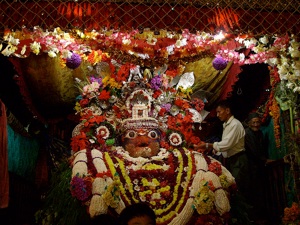
My interest was piqued by Goudriaan and Gupta’s description of the Ākāśabhairavakalpa whose main deity, Ākāśabhairava, is “a fearsome winged deity, a manifestation of Bhairava, who is invoked in various ways–of course by means of mantras–for the sake of exorcism.” who “manifests himself in three forms, viz. Ākāśabhairava, Āśugāruḍa, and Śārabha…” (Hindu Tantric and Śākta Literature 1981: 115) Given my research interests, I thought the second form sounded promising, and was further spurred to seek out this text by a posting on the Mānasataraṅgiṇī blog where the blogger mentions the text as “a combination of the bhairava srotas with the earlier garuḍa-srotas” (“A Discursion on the Sanatkumārīya Pañcabrahma (siddha-śaṅkara) Tantra and the Early Evolution of the Dakṣiṇaśaiva System” January 5, 2010). The staff of the NGMCP graciously allowed me to view copies of several Nepalese manuscripts of the text. For my own purposes of scoping out the text for Gāruḍa material, I have made a list of the chapter titles:
Chapters 1–71 are from NGMPP reel number A 144/13
Chapters 72–81 are from a different manuscript, A 145/9
<> indicates that the title was not given or illegible. I occasionally checked uncertain words against the other MS.
1: utsāhaprakrama (–f.2r)
2: yajanavidhi (–f.3r)
3: utsāhayajana (–f.4r)
4: utsāhābhiṣekavidhi (–f.5r)
5: mantrayantraprakrama (–f.6r)
6: citramālāmantra (–f.7v) 7: vaśyākarṣaṇaprayoga (–f.8r)
8: mohanadrāvakaprayoga (–f.8v)
9: stambhavidveṣaprayoga (–f.8v)
10: uccāṭananigrahaprayoga (–f.9r)
11: bhogaprada (–f.9v)
12: āśutārkṣyavidhi (–f.10v)
13: āśugāruḍaprayoga (–f.11v)
14: āśugāruḍakavaca (–f.13v)
15: śiṣyācāravidhi (–f.15r)
16: <śarabhasāluvapakṣirājakalpa*> (–f.16v) = title of ch.81?
17: śarabheśāṣṭakastotramantra (–f.18r)
18: <mālāmantra> (–f.20r)
19:(–f.20v)
20:(–f.22r)
21: <(no title)> (–f.23r)
22: rakṣābhiṣekhavidhi (–f.24r)
23: balividhāna (–f.25v)
24: <sadācāravidhi> (–f.28r)
25: māyāprayogavidhi (–f.29r)
26: ācāravidhi (–f.29v)
27: mātṛkāvarṇana (–f.32v)
28: bhadrakālīvidhi (–f.33r)
29: auṣadhavidhi (–f.35r)
30: śūlinīdurgākalpana (–f.37r)
31: śūlinīvidhi (–f.41v)
32: vīrabhadrakalpa (–f.42v)
33: jagatkṣobhaṇa<mālāmantra> (–f.45r)
34:(–f.46r)
35: balividhi (–f.47v)
36: kṣetrapālavidhi (–f.49v)
37: vaḍavānalabhairavavidhi (–f.50v)
38: dikpālavidhi (–f.51v)
39: vyādhikalpa (–f.52r)
40: mṛtyuvidhi (–f.52v)
41: śarabhakavaca (–f.57v)
42: manmathaprayoga (–f.59v)
43: cāmuṇḍāvidhi (–f.60v)
44: mohinīvidhi (–f.61r)
45: drāviṇīprayoga (–f.61v)
46: śabdākarṣiṇīprayoga (–f.62r)
47: bhāṣāsarasvatīmantraprayoga (–f.63r)
48: mahālakṣmīprayoga (–f.63v) 49: māyāvidhi (–f.64r)
50: pulindinīvidhi (–f.64v)
51: mahāśāstāvidhi (–f.68v)
52: saṃkṣobhiṇīvidhi (–f.69r)
53: dhūmāvatīvidhi (–f.69v)
54: dhūmāvatīprayoga (–f.70r)
55: nadyuttāraṇavidhi (–f.71r)
56: citravidyāvidhi (–f.72v)
57: deśikastotra (–f.74v)
58: duḥkhasvapnanāśanamantravidhi (–f.75r)
59: pāśavimocana (–f.75v)
60: gaṇapatividhi (–f.76v)
61: auṣadhamantravidhi (–f.78r)
62: mūlikāvidhi (–f.79v)
63: kālamantravidhi (–f.80r)
64: ṣaṇmukhamantravidhi (–f.80v)
65: bhairavavidhi (–f.81r)
66: tvaritāvidhi (–f.82r)
67: vīrabhadravidhi (–f.82v)
68: vaḍavānalabhairavaprayoga (–f.83r)
69: brāhmīvidhi (–f.83v)
70: māheśvarīvidhi (–f.84r)
71: kaumārīvidhi (–f.84v)
——–
72: vaiṣṇavīvidhi (–f.32r)
73: vārāhīvidhi (–f.32v)
74: nārasiṃhīvidhi (–f.32v)
75: indrāṇīvidhi (–f.33r)
76: cāmuṇḍāvidhi (–f.33r)
77: sāluvabhujaṅga (–f.34r)
78: śarabhahṛdaya (–f.35v)
79: śarabhāṣṭottaraśata (–f.37r)
80: śarabhasahasranāma (–f.44r)
81: śarabhasāluvapakṣirājakalpa (–f.46r)
Unfortunately I did not notice any Gāruḍam material in my brief look through the text. If anyone reading this knows of something there I overlooked, please let me know. The Āśugāruḍa form of Bhairava seems to be more of a general purpose kavaca procedure. The Tvaritā chapter (66) mentions nothing about poison or snakes, only giving her mantra (notably the word vidyā is not used) in an encoded form. There seems to be an abundance of references to exorcism (in the tradition of the Bhūta Tantras), which accords with what Goudriaan and Gupta wrote, quoted above. It certainly would be a boon to have this typed in and edited, but I’m afraid I won’t be able to get to that for some years to come.